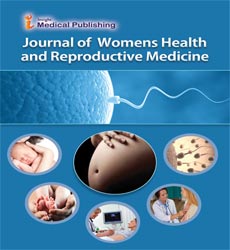Genetics of Female Infertility in Humans
Nguyen Dac*
Biomedical Department of Internal and Specialist Medicine, University of Palermo, Palermo, Italy
- *Corresponding Author:
- Nguyen Dac
Biomedical Department of Internal and Specialist Medicine
University of Palermo
Palermo
Italy
E-mail: dacnguyen@gmail. com E-mail:
Received Date: May 05, 2021; Accepted Date: May 19, 2021; Published Date: May 26, 2021
Citation: Nguyen D (2021) Genetics of Female Infertility in Humans. J Women’s Health Reprod Med Vol. 5 No. 3: e014.
Description
About 10% of women of regenerative age can't envision or pass on a pregnancy to term. Female factors alone record for in any occasion 35% of all unprofitability cases and incorporate a wide extent of causes impacting ovarian development, improvement of oocytes, and treatment capacity, similarly as the ability of a pre-arranged egg for preimplantation progression, implantation, and fetal turn of events. Genetic inconsistencies provoking desolateness in females incorporate tremendous chromosome abnormalities, submicroscopic chromosome eradication and duplications, and DNA progression assortments in the characteristics that control different common cycles entangled in oogenesis, backing of ovarian hold, hormonal hailing, and anatomical and utilitarian improvement of female regenerative organs. Notwithstanding the phenomenal number of characteristics trapped in regenerative physiology by the examination of animal models, simply a subset of these characteristics is connected with human desolateness. In this review, we mainly revolve around innate changes recognized in individuals and summarize progressing data on the sub-nuclear pathways of oocyte headway and advancement, the basic occupation of maternal-sway factors during embryogenesis, and inherited conditions related with ovarian dysgenesis, fundamental ovarian inadequacy, beginning phase lethality, and unproductiveness.
Female infertility
Infertility is an especially astounding issue of the conceptive system. There are 2 sorts of male or female sterility: Primary and discretionary. The fundamental design impacts germ cell development or physiology, causing catch of germ cell progression and finally cell death. Fundamental female unproductiveness consolidates inauspicious ovarian frustration (POF), polycystic ovary condition (PCOS), endometriosis, and leiomyoma. Fundamental male sterility upsets spermatogenesis and is connected with uncommon semen (i.e., weird sperm check, morphology, or motility), yet consistently the semen is normal (idiopathic pointlessness).
Discretionary fruitlessness arises due to fundamental or syndromic genetic disfigurements, including developmental, endocrine, and metabolic defects. Genetic confusion that show male or female unproductiveness are fragile X condition, Kartagener's condition, myotonic dystrophy, Noonan problem, Fanconi iron inadequacy, sickle cell shortcoming, β-thalassemia
Infertility is described as failure to consider in the setting of standard intercourse inside 1 year for women more energetic than 35 years inside a half year for women more settled than 35 years. The inescapability of unprofitability is some place in the scope of 7% and 15%. There are various explanations behind pointlessness, with appraisals of female factor infertility as an explanation in up to 37% of couples and both male and female consider vanity 35% of couples. Explanations behind female desolateness fuse ovulatory wrecks, chromosomal inconsistencies, endometriosis, pelvic grasps, tubal blockage and other tubal oddities, and hyperprolactinemia. There is creating verification that innate inconsistencies are accessible in as various as 10% of infertile females and 15% of pointless folks. There is moreover evidence to suggest that chromosomal anomalies and single quality changes add to the justification desolateness in a degree of couples searching for unproductiveness treatment. In 2002 the Italian social class of specialists working in regenerative prescription attempted to set out rules for the reasonable usage of innate testing in desolate couples.
Differential finding: Genetic purposes behind female unproductiveness join ovulatory issues like Kallmann problem, fragile X condition, similarly as karyotype peculiarities, and fundamental ciliary dyskinesia. Pointlessness can similarly be noted as a minor sign in various other genetic conditions including galactosemia, mucopolysaccharidosis, Prader-Willi, cystic fibrosis, pseudohypoparathyroidism type 1a, reformist external ophthalmoplegia, resistant framework polyglandular jumble type I, ovarian leukodystrophy, ataxia telangiectasia, Demirhan issue, and blepharophimosis-ptosis-epicanthus inversus condition.
Monogenic structures: In choice to the single quality distortions noted previously, extra extraordinary innate irregularities have been recognized in unbeneficial women. These recollect changes for the follicle-animating synthetic (FSH), luteinizing-compound (LH), and gonadotropin-conveying substance (GnRH) receptors, and changes in the androgen receptor causing androgen cruelty condition.
Family history: A three-age family for innate issues should be gotten from any tenacious who is going through appraisal or treatment for unproductiveness. A family foundation of folks or females with insightful powerlessness may show transmission of sensitive X condition, and testing for this issue is appeared.
Twin looks at: Twin considers have shown a more important concordance between monozygotic than dizygotic twins concerning season of menopause. The prevalence of troublesome ovarian dissatisfaction is three-to fivefold more conspicuous in both monozygotic and dizygotic twins. There are reports in the composition of "ovarian discordancy" in monozygotic twins, and moreover of sister → sister ovarian tissue transplantation in these cases.
Genome-wide affiliations: Genome-wide alliance considers (GWASs) have been used to explain the genetic etiology of inauspicious ovarian frustration. Candidate characteristics have been perceived; regardless, the little size of these examinations has confined the quantifiable power of their results. Bunch relative genomic hybridization (a-CGH) assessment is moreover being investigated on mates of women with unfavorable ovarian dissatisfaction for examination of copy number varieties (CNVs) over the genome. Different potential contender characteristics including PTHB1 and ADAMTS19 have been perceived in this plan, though greater resulting examinations are relied upon to certify these disclosures.
Open Access Journals
- Aquaculture & Veterinary Science
- Chemistry & Chemical Sciences
- Clinical Sciences
- Engineering
- General Science
- Genetics & Molecular Biology
- Health Care & Nursing
- Immunology & Microbiology
- Materials Science
- Mathematics & Physics
- Medical Sciences
- Neurology & Psychiatry
- Oncology & Cancer Science
- Pharmaceutical Sciences
